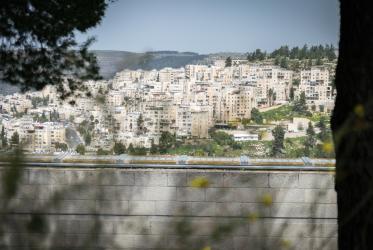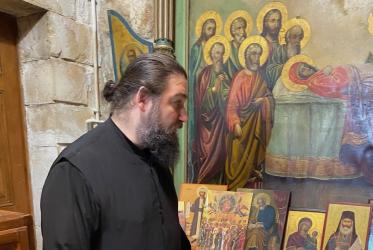Why was Jesus crucified? What implications does this have for the meaning of Jesus’s cross for us today? As Holy Week approaches, we seek to follow in the steps of Jesus as he makes his final journey from Jericho to Jerusalem—a journey which will result in his death a few days later.
The following series of reflections looks at several stopping points on this last journey of Jesus. We begin with his experience of Jericho, because it is the location where his initial profound and challenging choices will need to be made.
To grapple more deeply with the life and passion and death of Jesus, it is important to explore it in the context of the politics and history of the New Testament period. There are not, nor should there be, easy correlations between situations then and now. But the passion cannot be understood apart from politics. Jesus lived his life in a milieu in which his compatriots (and others) differed profoundly in their response to the political realities of his day. Support the rule of Rome? Collude with it for one’s own advantages? Oppose it, with armed force if necessary? Long for a Messiah, a “Son of David,” who will come and triumph over his people’s enemies? Seek to isolate oneself and hide away in safety? As we travel with Jesus on his journey, which we can truly say has changed the course of human history, we hear the echoes of these questions both in the biblical texts and in the landscape he encountered.
Blessed is the king who comes in the name of the Lord! Peace in heaven . . .. If you, even you, had only recognized on this day the things that make for peace! —Luke 19:38, 42
Even these days, even someone like myself who has been privileged to live in Jerusalem for a number of years, can find my heart missing a beat when I catch my first glimpse of Jerusalem’s Old City from the summit of the Mount of Olives. I wonder what it was like for Jesus on that day when he arrived from Jericho? Remembering that first Palm Sunday is an important mark of celebration and identity each year for the Christians of the Holy Land. It has been a deep sadness when, in some years, some Palestinian Christians have not received permission to visit Jerusalem to participate.
The account of what is often called Jesus’s triumphal entry—his riding into the city via the Mount of Olives on a colt (the Synoptic Gospels) or donkey (Gospel of John)—is recounted in all four Gospels, although there is a slightly different emphasis in each. We began our journey from Jericho up to Jerusalem with the Gospel of Luke; so having journeyed through the wilderness and stopped in Bethany, we will return to Luke to accompany us once again.
If we take a careful look at how the story is retold in Luke 19:28–40, we discover that there are no palms mentioned, nor any other kind of greenery. Luke’s account of Jesus’s arrival in the city is far less triumphalist than that of any of the other Gospels. Although Jesus is proclaimed as a king (19:38) it is clear that he is a very different sort of king from that of people’s expectations. In the next line, peace is mentioned, as Jesus’s disciples call out “Peace in heaven.’”
Interestingly, that word peace is not used at all in the story as it told by Matthew, Mark, or John. Yet it is a motif that is woven deeply into the fabric of Luke’s understanding of these events. Surely it is not accidental that it is Luke who emphasizes more than the other Gospel writers that this is happening on the Mount of Olives (19:29,37), since the olive is an ancient symbol for peace? Did those who celebrated Jesus’s entry into Jerusalem that day realize that they were welcoming a prince of peace? At first sight it looks as though they did, with their song of celebration, “Peace in heaven.” Yet look carefully, for the song is an ironic counterpoint to that sung by the angels at Jesus’s birth. The angelic choir chanted “Peace on earth” (Luke 2:14) while the disciples now sing “Peace in heaven.” Surely, we should be on the side of the angels: it is peace on God’s earth we need and are called to struggle for! Peace in heaven can all too easily become an escapist diversion. Peacemaking has to happen on earth, and it is an activity that can be very costly indeed to those who are brave enough to engage in it.
Jesus then goes on to weep over the city. One of the iconic views of Jerusalem is the glimpse through the plain west window of the church of the Dominus Flevit (“the Lord wept”) on the Mount of Olives, which commemorates that event. His lament then explicitly reminds us of the tragic consequences of the lack of peace (19:41–44). Today is a moment of decision not simply for Jesus, but also for Jerusalem, and the shadow of the cross is already cast firmly across his path. Instead of green foliage, Jesus’s path in this gospel is quite literally strewn with rocks and stones. Jerusalem’s very name seems to incorporate the Hebrew word for peace: shalom. Yet there is a clash—head on—between the vision of peace that Jerusalem was called to be, and the way this city instead has so often been a theatre of war. Its stones may sing of Jesus, but those same stones will be dashed to the ground over and over again, throughout the history of human hatred.
The city of Jerusalem is a parable and a sacrament of the human condition. It symbolizes our longing, our highest and best desires, our love of beauty, and our desire to worship God. But it is also a powerful reminder of how this best can go so tragically wrong—precisely because we find it so difficult to love without also seeking to possess. We want God on our own terms, housed in our own building, from which we will exclude all those who do not see things quite as we do. We all want our own Jerusalem, and our fractured world is the result. Jerusalem is the place where God is crucified by the desires and aspirations and passionately-held beliefs of men and women. Yet this same cross, the painful result of humanity’s peacelessness, can and must become “the way that leads to peace.”
By Dr Clare Amos, former programme coordinator for Interreligious Dialogue and Cooperation at the World Council of Churches





